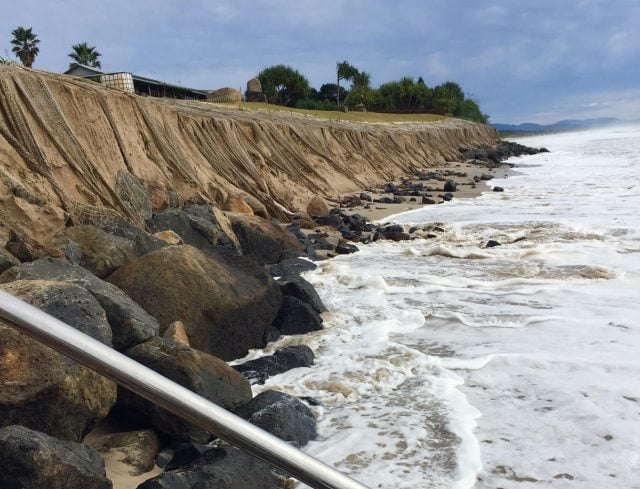
Hans Lovejoy
According to a former councillor and civil engineer specialising in hydrology, rock wall development applications (DAs) submitted by wealthy Belongil landowners will transfer public land to private ownership and eventually result in the loss of the iconic beach.
Both the NSW office of environment and heritage (OEH) and Council have yet to explain how the five rock walls DAs, which cover both public and private lands, will not result in beach loss.
As previously reported, the DAs were submitted by the landowners – almost all of whom are non-residents – to the NSW Coastal Panel.
The DAs close for public submission with the independently appointed panel on April 20.
There was also no reply to The Echo’s question as to whether the OEH website provided sufficient information, given the DAs are not visible or easy to navigate to.
OEH staff replied briefly when asked to confirm that the Belongil rock wall DAs were on Crown/Council land.
The Echo asked, ‘If correct, would that mean that all liability is unclear?’
A OEH spokesperson replied, ‘Notification of development applications is undertaken in accordance with the requirements of the Environmental Planning and Assessment Act 1979 and it is the responsibility of proponents to seek consent from any relevant landowners where development is proposed. The NSW Coastal Panel welcomes public submissions during the submission period.’
Comment was sought from Council staff, but no reply was given by deadline.
Unanswered questions
Other questions not answered by OEH and Council were: ‘Will there be a sand mitigation requirement, given these DAs may well lead to further beach erosion? The Echo understands that these DAs are being assessed under the now-repealed Coastal Protection Act 1979, which requires sand mitigation under these types of circumstances. ‘What guarantee is there that these walls will not result in Belongil beach becoming a private enclave and a loss for public amenity?’
Within the DAs, the works are referred to as repairs, but says that the existing rocks will be removed, inspected and the walls then rebuilt.
Owing to the 2016 court-endorsed agreement by Justice Hoeben between the landowners and Council’s insurers, the DAs appear to have avoided having to comply with legislation that requires sand mitigation and coastal protection.
In other words, when building seawall structures, similar DAs would be required to ‘protect and manage the natural, cultural, recreational and economic attributes of the NSW coast,’ (Clause 7 of SEPP No. 71).
Instead, the applicants are able to ignore these considerations – and more, and instead argue ‘… it is in accordance with a court injunction’ (page 17, Statement of Environmental Effects, 44–48 Childe St DA).
It’s estimated 24 tonnes will be imported for the 44–48 Childe Street property alone.
Rationale
The rationale for the works, according to the 44–48 Childe St DA, is ‘to ensure that this small part of the coastline is better equipped to withstand coastal processes/storm events, and to avoid potential safety issues if the wall is not repaired. The proposed repairs to the seawall are intended to preserve the status quo and improve public safety. They are contemplated by the court orders.’
No govt assistance
Questions by The Echo to former planning minister Rob Stokes at the time as to why Council received no assistance from the government with its court case were never replied to.
Duncan Dey, who was a councillor when Council’s insurer was taken to court by the landowners in 2016, told The Echo, ‘Belongil landowners had a big scare early in the naughties and some responded by dumping rocks on the dune face that their properties inhabited.’
‘Some of those rocks spilled out onto public land at the back of the beach. Under some beach conditions, no beach remained and waves reached those walls.
‘That situation is predicted to occur more often in the future as the sand supply dwindles and sea level rises.
‘Rather than switching to an exit plan, some landowners then also commenced a court claim on Council for damages over previous decades.
‘The enormity of the claim meant it couldn’t be defended by Council, who passed the matter up to their insurer.
‘It was also too large for the insurer, who passed it up to their underwriter.
‘The enormity of the claim got the matter out of the hands of the local caring community and into the hands of someone who just wants to minimise their financial exposure.
‘The science behind the claim shifted over the many years that the case ran. Eventually, towards the end of the court action, a settlement was offered that the underwriter found attractive: no payout but agreement that existing (mostly unapproved) rock walls could stay and be rebuilt to the standard proposed in the then draft Coastal Zone Management Plan (CZMP).
‘That CZMP was the one agreed to by the pro-rocks Council 2012–16.
‘During the decade or so of the court proceedings, updates to Council were branded confidential along with reminders that breaking that confidentiality could be used by the underwriter to shed their liability and leave Council exposed directly and on its own to the enormous claim.
‘The second success of this process, from the claimants’ perspective, was that the caring community never found out what was being done to us. The settlement thus came out of the blue and eclipsed the pro-rock CZMP.
‘It was an even worse outcome than the CZMP (if you value beach over real estate) because it invited the landowners to lodge the DAs that are now on exhibition until April 20. The word “repair” in the DAs is a name only. As agreed in court, their scale goes beyond repair up to the size of the CZMP.
Public cost
‘The end game, that goes beyond any construction now or in the future, is the gaining of these approvals. The next court action will then be to establish that the public purse maintains these rock walls rather than the landowners. The job is then done and the real estate investments reach their full water-frontage value, because they do not carry liabilities for their own coastal protection. That cost falls on us, the public.
‘Damage to any armouring is inevitable, even if the walls are built to a one-in-whatever-year standard.
‘The large storms that once placed the dunes at the back of the beach will return.
‘Dunes work like a “sand bank” – nature deposits the sand handily at the back of the beach and borrows from it in later storms to replenish the beach.
‘This exchange generally prevents storm waves travelling inland, by having the waves’ energy smash onto the sloping beach. Removing the beach or locking up the sand under a building is not smart. Rock walls do both.
‘So when the inevitable future damage occurs, government bailout will look after the coastal investors.
‘Hmmm, sounds like a banking collapse!’
As reported in 2016, almost all of the property owners who took Council to court and are applying for these DAs do not live in Byron Shire.
The applicants
The applicants for the DAs are: John James (Ralph Lauren Pty Ltd), who is a wealthy Brisbane-based developer, multi-millionaire former online employment business Seek director Robert Watson, Geoffrey Tauber (Stewartville Pty Ltd), who is based in Melbourne, and Michael Siddle, who is based in Sydney and is chair of the enormous Ramsay Health Care corporation.
Lastly, local musician and TripADeal Pty Ltd director Kurt Rettenmaier has lodged a similar DA for his new Childe Street address, yet was not part of the original court case against Council.
The DAs are available via www.environment.nsw.gov.au at bit.ly/2IXzDFL.




The information in this article is simply wrong!
Duncan Day’s limited understanding of the court settlement over the rock walls and indeed his understanding of coastal processes expresses in the article simply demonstrates his ignorance.
Court case:
A settlement was reached after years of needless protracted litigation where Council finally did not, nor could not offer a effective defence.
The Belongil residents case was simple, the Council built rock headland structure in town that structure has caused a realignment of the coast.
Our rock structures built later in-defence of that realignment over the last forty years with Council and Court approvals should be and were protected by the Court settlement. All well educated coastal experts agree with this premise.
Coastal Processes:
Duncan the beaches here on the North Coast are not reformed from storm eroded dunes as you suggest!
The beaches here are formed and reformed form natural north-bound sand transport which reforms the beaches in Byron Bay after storm events.
That’s why the Belongil still has an extensive beach in front of the 40 year old rock walls.
Half a million cubic metres of sand on average makes its way north around Cape Byron. That is why there has been a massive beach at Belongil over the last few years. This sand transport system has formed all the sand islands to the North. These include, Stradbroke North and South, Morton and the biggest sand island in the world Fraser.
Council was informed:
A number of reports to council from the late 1960’s 1970s and later informed the Council of the impact of the Jonson St rock works , In particular a report by coastal expert Dr Peter Roy in 2001 commissioned by the NSW Coastal Council was copied by the Chair, Professor Brue Thom to Byron Council in January 2002; contrary to earlier studies, Roy noted the coast was largely stable and then recent adverse changes from circa 1960s were probably due to realignment to the coast caused by man-made structures such as the Byron Bay’s Jonson St protective works and river training walls impacting the natural sediment transport regime. ROY states, “An alternative and more recent view of coastal recession at Byron Bay…is that the rates of recession have changed over time and the history of the recent episode of erosion is probably quite short lived. A combination of factors are thought to be involved…Second, in Byron Bay itself it is likely that the plan-form shape of the embayment is segmenting in response to the construction of rock breakwaters and revetment on the beach face”. —- Roy adds, – a “continuous sand feed model has allowed the northern NSW coast to maintain a dynamic stability over millennia, albeit with fluctuations of accretion and recession due to climatic variables” ROY 2001 p 77 p 88
“There is clear evidence that much of the Byron Bay shoreline has undergone severe erosion in the past 30 years or so. Earlier studies that attributed the erosion in large part to natural geological phenomena have been re-evaluated. It now seems likely that the present erosion cycle may have been initiated relatively recently and be a response to anthropomorphic [ man- made] well as natural causes .” ——————-
“Anthropogenic causes of erosion relate to coastal structures both in Byron Bay and updrift (to the south) which have interfered with alongshore sand movements and caused coastal realignments. The relative importance of these variables is largely unknown, especially the impacts of climatic fluctuations and coastal structures which have unpredictable durations.” ROY 2001 p91 p92
So do your home work before expressing suck negative biased and simply wrong information.
The war on us by the filthy rich continues on every front. Their avarice will never be satisfied. And as the article points out, not only do we lose our common wealth, we must then pay for the parasites to keep the wealth they have stolen.
Australia needs system change NOW.
I live in Sydney on The Northern Beaches. The Collaroy-Narrabeen strip is in a not too different situation to Belongil. Our beach strip is notorious for storm related beach erosion. The 2016 East Coast Low impacted the Collaroy-Narrabeen strip quite heavily with some 10 properties worth multi millions on the beach/ocean front almost sucked into the briny. Our Council spent the equivalent of $4million dollars in ‘protecting’ the 10. Now they want a seawall for themselves. no doubt to protect their ‘investment’. We have 100 years plus of history along Collaroy-Narrabeen. They can’t quite rightly can’t home insurance and so look to the Council / public purse to bail them out. It will just replay each time an East Coast Low comes calling.There should be no sea wall, there should be no homes on the beach front fullstop. For the last 2 years it has just been a whingefest from the ’10’ as they complain about their perceived lack of help from insurance companies, the council and the state government. The ’10’ knew the risks living there.
It’s ok to protect Byron township with rocks on the beach even though those existing rocks amplify beach erosion to the north and can cause private landowners to loose their homes?
It ok for Belongil landowners to loose their homes because they are wealthy?
It’s ok for public access to Belongil Beach via Manford and Gior Streets to succumb to beach erosion?
It’s ok for state and local governments to collects million$ in tax from Belongil landowners but none of this money should be spent protecting Belongil property (and public beach access)?
No wonder BSC’s (and apparently, the Echo’s) case is indefensible!
Meanwhile, a far more disastrous wall proposal looms.
The ruination of Byron Bay marches on with the progress of The West Byron folly!? Build a large Trump-like wall so that the development atrocities behind it can proceed.
Long live the foolish, ugly and ordinary!